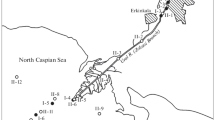Abstract
Based on field observations, the regularities of dissolved matter migration in the mouth areas of rivers of Russia’s Black Sea coast (the Anapka, Ashamba, Mezyb, Hotetsai, Vulan, Kudepsta, and Mzymta rivers) were studied. The conservative behavior (a linear form of the relationship between the component concentration and chloride content) was established for a number of major ions and trace elements: Na, K, Mg, SO4, Li, Rb, Cs, Sr, Co, Ni, Cu, Cd, Sb, Ga, B, F, V, As, Mo, and U. The conditionally nonconservative behavior of calcium and hydrocarbonates also actually corresponds to the conservative behavior, since their excess in the mouths of some rivers is associated with the influx of dispersed groundwater runoff into the mixing zone, in addition to river water. The nonconservative behavior (nonlinear form of the relationship between the component concentration and chloride content, indicating its participation in autochthonous processes in the mixing zone between river and sea water masses) is typical of nutrients involved in production–breakdown (P, Si) and sorption–desorption (P) processes; barium, to a greater or lesser extent is desorbed from river suspended particulate matter (from ∼0 to 390% of its concentration in river water), as well as for Mn, Fe, Pb, Al, Ti, Y, and rare-earth elements, which are removed from the solution during coagulation and flocculation of organic and organomineral colloids (from ∼0 to 85%). The spatiotemporal variability of the distribution of dissolved major and trace elements in the mixing zone between river and sea water masses depends on the variability of the chemical composition of continental runoff and differences in element concentrations at the river and sea boundaries of the mixing zone: an increase in this levels the influence of the first factor. Earlier data revealed the similarity of types of distribution of dissolved major and trace elements in the mouths of large and small rivers of the Russian sectors of the Black and Caspian seas, which differs only in the degree of involvement of elements in certain autochthonous processes at the mouth of each river in a specific period of time.









Similar content being viewed by others
REFERENCES
V. V. Gordeev, Geochemistry of the River–Sea System (Moscow, 2012) [in Russian].
V. V. Gordeev, A. S. Filippov, M. D. Kravchishina, et al., “Specific Features of the River Runoff to the White Sea,” in White Sea System (Nauchnyi Mir, Moscow, 2012), Vol. 2. Water Layer and the Atmosphere, Cryosphere, River Runoff, and Biospere Interacting with It. Chapter 4, pp. 225–308 [in Russian].
P. N. Makkaveev and P. O. Zav’yalov, “Runoff of Small Rivers of the Russian Cost of the Black Sea and Its Effect of the Characteristics of Waters,” in Black Sea System (Nauchnyi Mir, Moscow, 2018), Chapter 3. Geochemistry of River Runoff to the Black Sea, Sect. 3.2, pp. 287–322 [in Russian].
A. V. Savenko, V. F. Brekhovskikh, and O. S. Pokrovskii, “Migration of dissolved trace elements in the mixing zone between Volga River water and Caspian seawater: Results of observations over many years,” Geochemistry Int. 52, 533–547 (2014).
A. V. Savenko, N. A. Demidenko, and O. S. Pokrovskii, “Chemical transformation of the runoff of dissolved matters in the mouth areas of the Onega and Mezen’ rivers,” Geochemistry Int. 54, 439–448 (2016).
A. V. Savenko, N. A. Demidenko, and O. S. Pokrovskii, “Spatial and temporal variability of the transformation of dissolved matter runoff in the Mezen River estuary,” Oceanology 59, 199–207 (2019).
A. V. Savenko and L. E. Efimova, “Transformation of the Runoff of Dissolved Matter in the Mixing Zone of River and Sea Waters,” in Geological State of the Arctic Coast of Russia and Security of Management of Natural Resources (GEOS, Moscow, 2007), pp. 285–299 [in Russian].
A. V. Savenko and O. S. Pokrovsky, “Migration of dissolved matter at Serebryanka R. mouth, the basin of the Sea of Japan (Sikhote Alin Reserve),” Water Resources 41, 671–676 (2014).
A. V. Savenko and O. S. Pokrovsky, “Distribution of dissolved matter in the Yenisei estuary and adjacent Kara Sea areas and its inter-annual variability, ” Geochemistry Int. 57, 1201–1212 (2019).
A. V. Savenko and O. S. Pokrovsky, “Transformation of dissolved matter runoff in the Ural River mouth,“ Geochemistry Int. 58, 947–958 (2020).
A. V. Savenko, O. S. Pokrovsky, and M. N. Kozhin, “Transformation of the dissolved components runoff in the mouth areas of small watersheds of the southern coast of the Kola Peninsula,” Oceanology 51, 785–795 (2011).
A. V. Savenko, A. G. Tsytsarin, and E. S. Povalishnikova, “Behavior of strontium, fluorine, and boron in the Kuban and Don mouth areas,” Water Resources 29, 676–685 (2002).
Yu. P. Khrustalev, Patterns of Current Buildup of Sediments in Northern Regions of the Caspian Sea (Rostov-on-Don Gos. Univ, Rostov-on-Don, 1978) [in Russian].
Yu. P. Khrustalev, Patterns of Buildup of Sediments in Intercontinental Seas of the Arid Zone (Nauka, Leningrad, 1989) [in Russian].
V. M. Shulkin, Metals in Ecosystems of Shallow Waters (Dal’nauka, Vladivostok, 2004) [in Russian].
Funding
The study was financially supported by the Russian Foundation for Basic Research (project no. 20-05-00802).
Author information
Authors and Affiliations
Corresponding author
Rights and permissions
About this article
Cite this article
Savenko, A.V., Pokrovsky, O.S. Transformation of the Major and Trace Element Composition of Dissolved Matter Runoff in the Mouths of Medium and Small Rivers of Russia’s Black Sea Coast. Oceanology 62, 324–345 (2022). https://doi.org/10.1134/S0001437022030110
Received:
Revised:
Accepted:
Published:
Issue Date:
DOI: https://doi.org/10.1134/S0001437022030110



